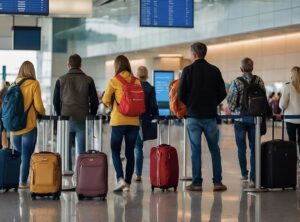 Preparing for your flight takes careful planning, and it’s easy to be caught off guard with all the rules on what you can and cannot bring on the flight, or what type of ID is accepted. Fortunately, TSA recently implemented a way to text your questions before you fly. Instead of sending an email or waiting on hold, this option can be easily used for fast and current information. Be better prepared before you walk into the security line! Here’s how the texting system works and why you should consider it.
Preparing for your flight takes careful planning, and it’s easy to be caught off guard with all the rules on what you can and cannot bring on the flight, or what type of ID is accepted. Fortunately, TSA recently implemented a way to text your questions before you fly. Instead of sending an email or waiting on hold, this option can be easily used for fast and current information. Be better prepared before you walk into the security line! Here’s how the texting system works and why you should consider it.
How to text the TSA. To start a chat, text “travel” to the AskTSA number (275-872). Within a few moments you’ll receive a response from an automated system. This system will try to answer your question with its algorithm (available 24/7) from the following categories: TSA PreCheck, What Can I Bring?, Identification, Medical Questions, Damages/Claims, Hiring, Other. Once you pick a topic, you’ll be directed to additional sub-categories until your question is answered.
Can I text a human at TSA? Once the service thinks it has answered your question, you’ll receive a text asking “Were we able to answer your question?” If you say no, you’ll be able to write your question, at which point a live agent will respond. Note that live agents are available from 8am through 6pm Eastern Time. If you’re texting outside of this window, you’ll need to wait to ask your question. Response times are usually around 10 minutes.
Why use this tool? When packing your carry-on for a flight, some dos and don’ts are straightforward but there is a lot of gray area that confuses even the most seasoned travelers. For example, ice is okay as long as it’s frozen solid, hard cheese is fine but creamy cheese is limited to 3.4 oz; snow globes are a no-go but formula, milk, and pureed foods are allowed for babies/toddlers – it’s enough to make your head spin! Having this option to quickly text can make the security process smoother, help you plan, and possibly save you time by preventing additional screening.
Rules can vary across airports. Also understand that the screening technology used at each airport and security line can affect what you must remove from your bag, as well as what documents you need to present to the TSA officer. It’s increasingly common to only show your ID without needing to scan your boarding pass, but this isn’t always the case. Some security lines allow even non-PreCheck flyers to keep their liquids and electronics in their bag. Follow the TSA officer’s instructions and keep an eye on what people in front of you are doing, and remember that errors can be a learning experience for next time.
The TSA website “What Can I Bring?” also has a lot of information about what’s allowed and not allowed. Plus, what can be placed in your carry-on and what is allowed but only in checked baggage. So in some cases a quick online search might be faster, especially if you have multiple questions. In any event, this new service provides one more easy option to help you prepare for your next trip, reducing time and stress.
If you have TSA tips to share, leave us a comment on our Facebook page!

 My goal is to simplify travel-planning through an equal exchange process where I acquire your ideas and expectations for your trip relieving you of the worry, hassle, stress and time that accompanies Do-It-Yourself planning.
My goal is to simplify travel-planning through an equal exchange process where I acquire your ideas and expectations for your trip relieving you of the worry, hassle, stress and time that accompanies Do-It-Yourself planning.